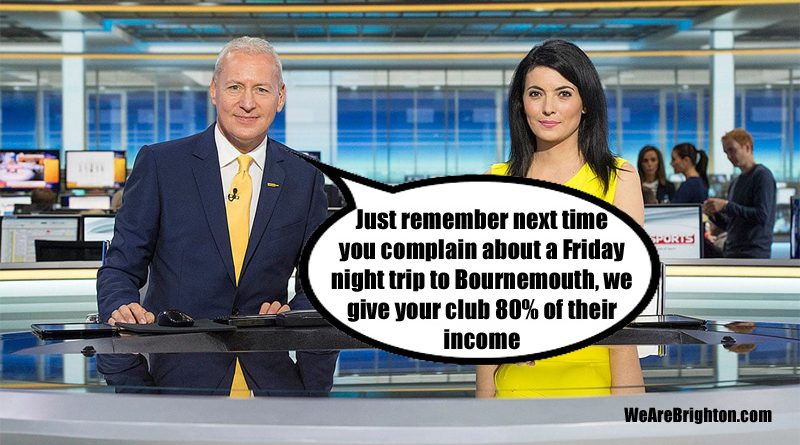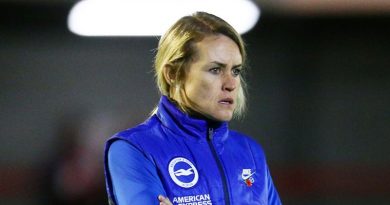What did we learn from Brighton’s 2017-18 season accounts?
Brighton and Hove Albion have published their first set of accounts as Premier League club and the wealth on offer for playing in the richest league in the world has helped the club turn a profit for the first time in years.
The Albion reported a profit of £11.3m for the 2017-18 season, a huge swing from the £38.9m loss that was incurred in their final season in the Championship when Tony Bloom gambled big on winning promotion.
That gamble has paid off big time as the latest accounts show. But looking beyond that headline profit number, the balance sheet revealed some interesting facts about the financial workings of the Albion.
Television rights account for 80% of the Albion’s income
We all love a moan when Sky or BT Sports send us to Liverpool at 5.30pm on a Saturday or decree that we’re off to Plucky Little Bournemouth on a Friday night with no way of getting a train home after. Tell Sky to shove their money some supporters cry, we want a 3pm kick off on a Saturday at the Vitality Stadium. But the contribution of television rights to the financial health of the club is massive. Brighton’s income last season was £139.4m and around £110m of that came from broadcast revenue, meaning that nearly 80% of the money the Albion brought in came from Sky, BT and the overseas television deal. Just remember that next time Everton at home is moved to a Sunday to accommodate a live audience in India.
Chris Hughton spent more in one season than the Albion had in the previous 116 years
Chris Hughton spent £57m on new players in the 2017-18 season. There are two ways to look at that. One is that it is a massive amount, probably more than the club had spent in the previous 116 years combined. The other is that it represented just half of the money that the Albion received as part of it’s broadcast revenue. Again, that just highlights what a contribution Sky and BT make to the Premier League and why club’s can afford to fork out £14m on the likes of Jurgen Locadia.
Brighton’s wage bill stands at nearly £80m a season
The Albion’s wage bill more than doubled with the jump from Championship to Premier League. In the promotion season, the club spent £31.3m on wages but in the Premier League that figure rose to £77.6m. Eight new additions for the first team squad would have swelled the bill while many of the players who won promotion were rewarded with new contracts with a rumoured top wage of £45,000 a week. That still wasn’t enough for David Stockdale of course, who is presumably enjoying counting all his cash while turning out on emergency loans in League One for the likes of Southend United and Wycombe Wanderers.
Tony Bloom is very generous man
It was revealed recently that Brighton have the second biggest debt of any football club in Britain, owing Tony Bloom an astonishing £207m for his investment in stadium, training ground and squad. As if that wasn’t generous enough, Bloom lent a further £32m to the Albion in 2017-18 by underwriting investment in new players and infrastructure despite the money the club were now raking in through their membership of the Premier League. That takes his total investment in the club to £318m. What a man.
Paul Barber is a very rich man
Bloom’s generosity doesn’t just extend to the Albion – he pays his Chief Executive handsomely as well. Paul Barber took home around £1.4m last season and that is likely to increase this year with his promotion to Deputy Chairman. To be fair to Barber, when you look at the way he has transformed the club off the pitch and the fact he has been rumoured to be in the running for much higher profile jobs at the Premier League and the Football Association, that is probably money well spent. If for nothing else than the time he spends concocting a 100 page e-mail response to Doris, 69 from Newhaven who has written in with her complaints that the cost of Bovril has gone up 5p.
The average Albion fan spend £32 per matchday at the Amex
Speaking of the price of Bovril, the Albion’s matchday income last season came in at £18.5m which worked out around £32 per fan per home game. That represents a 25% increase from the Championship promotion season despite there being four less home games. This is due to an increase in ticket prices and around 3,000 being added to the average attendance. In terms of the Premier League as a whole, that puts the club in the top 10 for match day income, ahead of established top flight teams such as Everton and the 2016 champions, Leicester City. Keep buying those pints, people.
If you’re interested in a more detailed analysis of Brighton and Hove Albion’s 2017-18 season accounts, then head on over to the brilliant Price of Football website.




